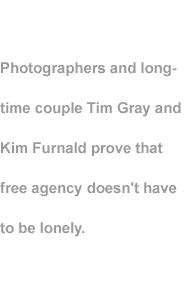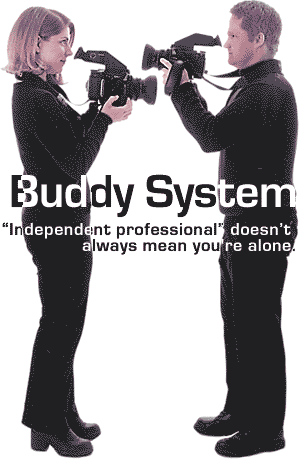 |
|
||||||||||||

|

|
|
By Jake Brooks
|
Freelance photographer Tim Gray, a former Merchant Marine and professional fisherman, sometimes misses lobstering. "I was on the water for so long, and it was so much a part of my life that I do miss it," he says. "But not enough to give up what I'm doing now." For the last six years, Tim and longtime girlfriend Kim Furnald have been working together as editorial photographers for Boston-area magazines. Neither began professional life as photographers or as free agents, but now Tim and Kim are happily both. As free agent collaborators, Tim and Kim live and work almost as a single unit, but they don't have a formal partnership, and each is free to accept or turn down work as he or she sees fit. When they do projects together, they split the take down the middle. They always file their taxes separately. "I'm sure someday when the business grows to a point where there'd be a tax advantage to change [the way we do] it, we would," says Tim. Until then, he says, "we're the accountants, we're the secretaries, we're the mail people, we're marketing, we're researching a Web site -- we're everything." After his Navy days, Tim had begun to study marine biology when he stumbled upon an art elective in photography. He tried it, loved it, and soon moved out of the research lab and into the photo lab. At about the same time, Kim, then an art student, got her first professional photo assignment while working as a design intern at Boston Magazine. A born free agent, she was starting to suffer from headaches from the stress of office work, so Boston's editors asked her to shoot some photos. Then they asked her to take others, and others, and others still. One day Kim brought in Tim to assist on a shoot, and a working relationship was born. Before long, with each other for professional and personal support, they decided to skip the traditional route into magazine photography (working full-time for a magazine) and instead go out on their own. They passed up the apprenticeships that are practically a rite of passage for would-be photographers, and gave up the security of long-term contracts, unions, and accounts-receivable departments. They became free agents. Beantown Paparazzi At the very beginning it was painful -- for Kim at least. "Every night I would wake up in a cold sweat," she says. "Tim never worried, just me. I did the worrying for the both of us. I'm the one with the short nails. It takes a while to train yourself not to worry." Yet since going out on their own, Kim and Tim say they've had no financial crises and have built a sturdy local reputation without benefit of marketing. They rely on word-of-mouth recommendations. Job-hopping art directors, for example, have helped them break into new publications. When the Boston art director they had first worked with moved to Natural Health, he took their services into new territory. In the small Boston magazine market, word spread quickly that Tim and Kim did solid work, and they've relied on their reputation ever since. "It's hard for [art directors] to find people who are reliable and aren't spooky," Kim says. Tim and Kim mostly shoot for Boston-based magazines, including Boston, Inc., Natural Health, CIO, and Fast Company. Unlike editorial photographers in larger markets like New York, they don't specialize in a particular type of photography, such as fashion work or product shoots. Over the course of a week, for example, they might do an executive portrait for Inc., a lifestyle spread for Boston, and in-studio shots of granola for Natural Health. Because they work almost exclusively for magazines, and not for design or advertising firms, Tim and Kim are at the mercy of some brutal editorial schedules. Many of the magazines they work for close an issue every month, leaving them little time for vacation. "One will give us maybe four assignments over one week," says Kim," and then another's cycle will kick in, and they'll assign the photography at the end of that week into the next, and so it goes." They grab a long weekend here and there, but Kim says that whenever she's away, Tim gets hit with more work than usual. No Thongs When you think of Tim and Kim, don't picture the globetrotters who shoot photos of thong-clad Cindy Crawfords and Elle McPhersons sprawled on Caribbean beaches. Running and owning a freelance photography business isn't as glamorous as the pictures suggest: Tim says that he and Kim spend only 20 percent of their time taking pictures. Most mornings, Kim wakes at seven, picks up the mail, and updates the accounting books. "I try to do all that early in the morning, since you can get interrupted in the middle of the day," she says. At nine, Tim rolls out of bed and begins negotiating with new clients or filing old film, a loathsome task. Over the years, the two have discovered their individual strengths and divided up the office work accordingly. When both of them are responsible for the same task, they say, nothing gets done. Afternoons are for taking pictures, and this job goes to "whoever wrestles the camera out of the other's hands." The photography itself is the exciting part of the job, but it's no less grueling than running the business. "Most people don't know what goes into making a photograph for a magazine," says Tim. "They don't understand the effort." When Tim and Kim did a shoot for a CIO story on the Citibank/Travelers merger last year, for example, their subject was a high-ranking executive with little time to spare. After scheduling and rescheduling, they finally caught up with her in New York. They flew down the night before, arrived at the site at 6 a.m., and spent the next two hours setting up and testing the lighting. ("They give you a certain room to work in, and you try to make it look different than the 50 million photographers who were there before you [did]," says Kim.) The actual shoot lasted ten minutes. Love and Politics Romantic involvement hasn't hurt Tim and Kim's professional life. "If it had," says Tim, "we probably wouldn't have continued working together." The photographers have found that their artistic sensibilities (lighting preference, say) are remarkably compatible. Also, since they interact with various other people in the course of their work, they don't feel claustrophobic or get on each other's nerves. As two people, they don't really have to deal with the hassle of office politics, and yet from their position on the fringe of the corporate magazine world, they can enjoy the melodrama of other people's politics. "It's nice to visit [the offices]," says Kim. "You get a sense of what their office politics are like, but you still have a sunny relationship. Then you leave. But you still get to hear about all the silly stuff that goes on. We've got some good gossip in Boston." |
|||||||||||||
|
October 27, 1999 Primary Editor: Eric Gershon Production: Keith Gendel |
We'd love to hear your comments about this article! Jake Brooks, a former Editor-in-Chief of Let's Go Travel Guides, is a co-author of Nice Job: The Guide to Cool, Odd, Risky, and Gruesome Ways to Make a Living. This is his first article for 1099. | |||||||||||||
|
| ||||||||||||||